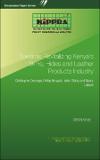| dc.description.abstract | The leather industry is among the strategic industries that offer opportunity for Kenya’s economic transformation and sustainable development. The industry contributes about 1.9 and 4.0 per cent to GDP and Agricultural GDP , respectively, and is estimated to employ 14,000 persons, with 10,000 being in the informal leather sector. Projections by 2030 indicate that the sector can employ over 35,000 people if the industry potential is exploited. Globally, there is a growing demand for leather products, estimated to increase by US$ 100 billion annually. The sector’s long value chain provides potential for job creation, income generation and poverty alleviation. However, Kenya may not reap any benefits from the positive global market indications if the limited value addition in the sector persists. This study reviews the policy, legal and institutional frameworks governing skins, hides and leather sector, evaluate the issues that bedevil the sector, and evaluate the possible opportunities for investment. The leather products industry is among the priority sub-sectors in the “Big Four” agenda of the Government of Kenya, which is expected to spur the contribution of manufacturing to GDP and employment. The potential of the skins hides and leather products value chain requires increased public and private investments across the value chain. At the lower level of the value chain, which entails production, specific opportunities relate to investment towards increasing livestock production and marketing to increase off-takes and increase supply of hides and skins as the basic raw material into the value chains, and investments to revamp skins, and hides extensions services to grow better quality skins. Moreover, investment in infrastructure will open interior markets and facilitate aggregation. | en |

